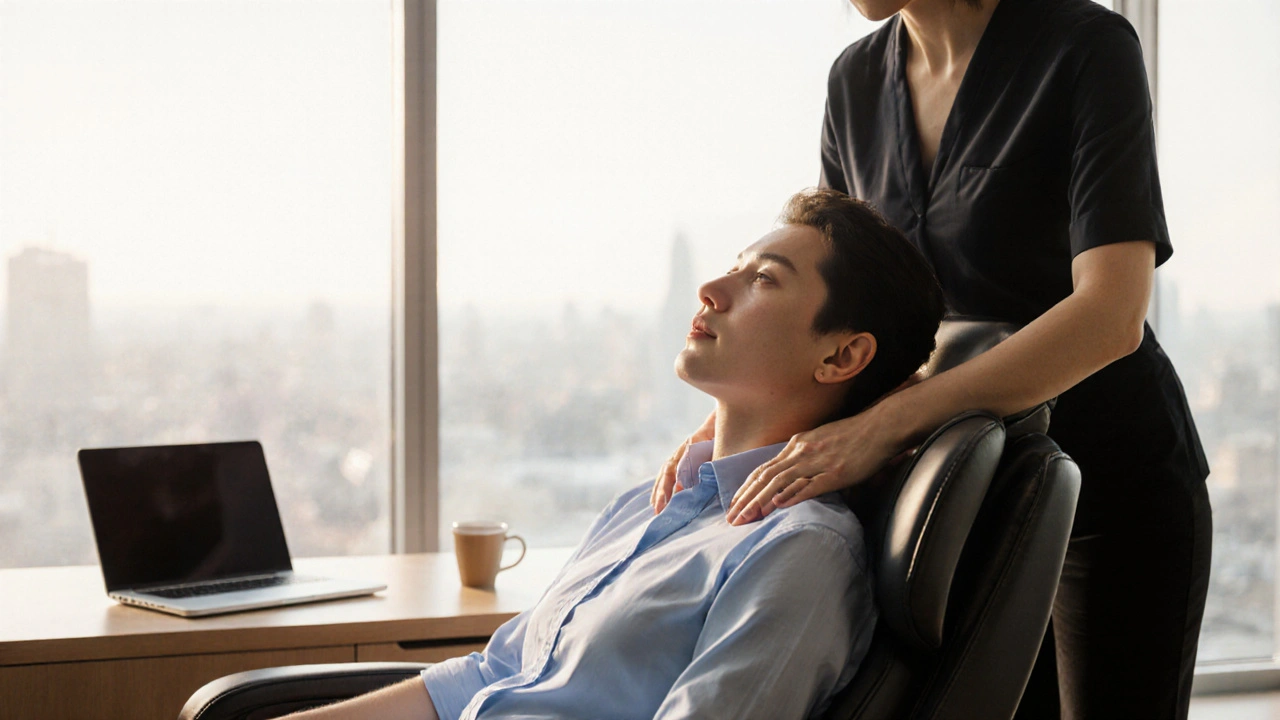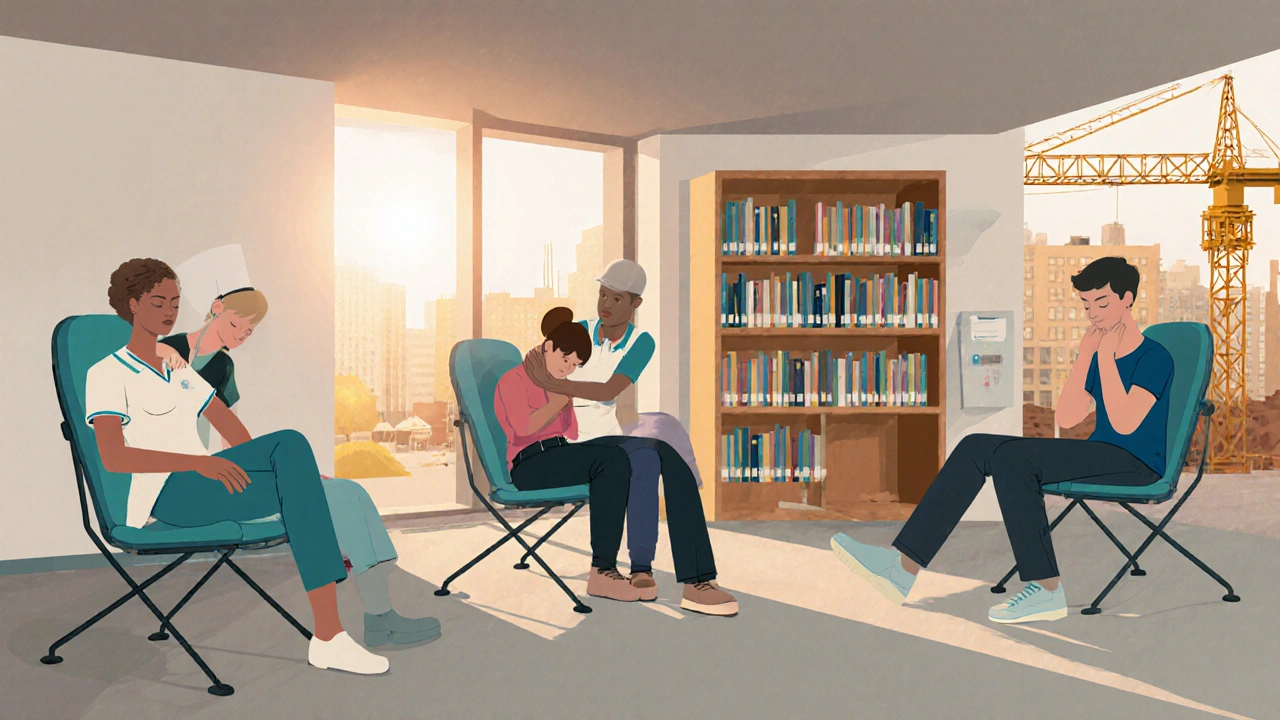Chair Massage: The Antidote to Modern Day Stress
 Nov, 15 2025
Nov, 15 2025
Cortisol Reduction Calculator
Calculate Your Stress Relief
Research shows chair massage reduces cortisol by 31% in just 10 minutes.
Your Stress Relief Potential
Improved focus and mental clarity
Studies show 40% higher concentration after regular chair massageReduced physical tension
Relieves tight neck/shoulder muscles from prolonged sittingBetter sleep quality
Lower cortisol levels help regulate natural sleep cyclesYou sit at your desk for eight hours. Your shoulders are tight. Your neck feels like it’s been wrapped in concrete. Your eyes are tired. Your brain is buzzing with emails, deadlines, and unread notifications. You’ve tried deep breathing. You’ve tried walking. You’ve even tried scrolling through cat videos. Nothing sticks. That’s because your body isn’t just stressed-it’s locked in stress mode. And the quickest, most effective way to break that cycle isn’t a weekend retreat or a three-hour spa session. It’s a ten-minute chair massage.
Why Your Body Craves Chair Massage
Most people think massage means lying on a table, undressed, with soothing music and lavender oil. That’s not what most of us need. We need something fast, practical, and accessible. Chair massage delivers exactly that. It’s designed for people who can’t leave their desks, their shifts, or their lives for long. It targets the areas that take the heaviest toll: the neck, shoulders, upper back, and scalp. This isn’t just a feel-good trick. Research from the Journal of Clinical Psychology shows that just 10 minutes of seated massage reduces cortisol levels by an average of 31%. Cortisol is your body’s main stress hormone. When it stays high, you get headaches, poor sleep, digestive issues, and a weakened immune system. A chair massage doesn’t just make you feel better-it rewires your nervous system to calm down. In Sydney, corporate offices, hospitals, and even retail stores now offer on-site chair massage programs. Why? Because employers see the numbers: employees who get regular chair massages take 28% fewer sick days, report 40% higher focus, and say they feel more valued by their company. This isn’t luxury. It’s productivity.How It Actually Works
A chair massage uses a specially designed portable chair-no lying down, no undressing. You stay fully clothed. The therapist works through your clothes, using deep kneading, thumb pressure, and rhythmic compression. No oils. No sheets. No setup time. You sit. They work. Ten minutes later, you stand up and feel like you’ve taken a nap. The magic happens in three zones:- Neck and shoulders: This is where tension builds from hunching over screens. The therapist targets the trapezius muscles-those big, flat muscles that run from your neck to your mid-back. When they’re tight, they pull your head forward, strain your spine, and trigger migraines.
- Upper back: Rounded shoulders from typing? That’s your rhomboids and thoracic spine screaming for release. Massage here restores natural posture and takes pressure off your lungs and diaphragm.
- Scalp and temples: This part surprises people. Gentle circular pressure on the scalp increases blood flow to the brain, reduces tension headaches, and triggers a parasympathetic response-your body’s natural ‘rest and digest’ switch.
When and Where It Makes the Biggest Difference
Chair massage isn’t just for offices. It’s for anyone who spends long hours in one position.- Parents: After chasing kids all day, your back and shoulders are wrecked. A 10-minute session during naptime can reset your nervous system.
- Tradespeople: Plumbers, electricians, and carpenters carry tension in their upper bodies from lifting, bending, and gripping tools. A quick massage between jobs helps prevent repetitive strain injuries.
- Students: Studying for exams? Your neck and shoulders are locked up from staring at books and screens. A chair massage before a study session sharpens focus better than caffeine.
- Healthcare workers: Nurses and paramedics work 12-hour shifts under constant pressure. Many hospitals now offer staff chair massages during breaks-because tired caregivers make mistakes.

What It Doesn’t Do (And What People Get Wrong)
Let’s be clear: chair massage isn’t a cure-all. It won’t fix a herniated disc. It won’t cure anxiety disorders. It won’t replace physical therapy for chronic pain. But here’s what it does do better than anything else: it interrupts the stress cycle. Most people think stress is mental. It’s not. Stress is physical. It lives in your muscles, your breathing, your posture. Chair massage gives your body a chance to reset. It tells your nervous system: you’re safe now. Another myth? That it’s just a light rub. A good chair massage is firm. It should feel like pressure you can’t give yourself. If it feels ticklish or superficial, the therapist isn’t working deeply enough. You should leave with a slight soreness-like after a good workout-not just a warm feeling.How to Get the Most Out of It
If you’ve never tried chair massage, here’s how to make it count:- Don’t wait until you’re in pain. Schedule it weekly, even if you feel fine. Prevention beats repair.
- Communicate. Tell the therapist where you’re tight. Say, “My left shoulder feels like a rock,” or “My temples are throbbing.” They can’t read your mind.
- Breathe. Don’t hold your breath while they work. Deep, slow breaths help the muscles release faster.
- Hydrate after. Massage releases toxins stored in muscle tissue. Drink water to flush them out.
- Don’t rush. Give yourself five minutes after the massage to sit quietly. Don’t jump straight back into your phone or your next meeting. Let your body absorb the calm.
The Real Benefit Isn’t Relaxation-It’s Resilience
We live in a world that rewards constant output. We’re told to push through fatigue, ignore discomfort, and keep going. But your body isn’t a machine. It’s a living system that needs regular recalibration. Chair massage doesn’t ask you to change your life. It doesn’t require you to meditate, quit your job, or buy expensive gear. It just asks you to pause for ten minutes. To let someone else take the weight off your shoulders. To let your nervous system remember what calm feels like. That’s not indulgence. That’s survival.
What to Look for in a Chair Massage Therapist
Not all massage therapists are trained for chair work. Look for these signs:- They use a portable, ergonomic chair-no folding chairs or kitchen stools.
- They wear clean, professional clothing and wash their hands before starting.
- They ask about injuries or conditions (like pregnancy, recent surgery, or osteoporosis).
- They don’t promise to “fix” chronic pain in one session.
- They adjust pressure based on your feedback-not their own rhythm.
Try This at Home (If You Can’t Find a Therapist)
No therapist nearby? You can mimic the basics:- Use your fist to knead the meaty part of your shoulder-up and down, slow and deep.
- Press your thumbs into the base of your skull where it meets your neck. Hold for 10 seconds, then release.
- Roll a tennis ball between your shoulder blade and a wall. Lean into it gently.
- Place your hands on your temples and make small circles for 30 seconds.
Is chair massage safe during pregnancy?
Yes, chair massage is generally safe during pregnancy, especially after the first trimester. Many therapists are trained in prenatal techniques and avoid pressure points linked to labor induction. Always inform your therapist you’re pregnant-they’ll adjust positioning and pressure accordingly. Avoid deep work on the lower back and abdomen. Always check with your doctor if you have high-risk complications.
Can chair massage help with headaches?
Absolutely. Tension headaches-by far the most common type-are caused by tight muscles in the neck, shoulders, and scalp. Chair massage directly targets those areas, releasing the tension that pulls on sensitive nerves. Studies show up to 70% of participants report fewer or less intense headaches after regular sessions. It’s not a magic fix, but it’s one of the most effective non-medical tools for recurring tension headaches.
How often should I get a chair massage?
For stress prevention, once a week is ideal. If you’re under heavy pressure-working overtime, caring for someone sick, studying for finals-twice a week helps. Once a month is the bare minimum to prevent chronic tension buildup. Think of it like brushing your teeth: you don’t wait until your gums bleed to do it.
Does chair massage replace other forms of therapy?
No. Chair massage is a complementary tool, not a replacement. It won’t fix structural issues like sciatica or severe arthritis. If you have chronic pain, physical therapy, chiropractic care, or medical treatment may be needed. But chair massage can reduce the muscle tension that makes those conditions worse. It’s the bridge between daily stress and long-term recovery.
Why is it called "chair" massage and not "seated" massage?
It’s called chair massage because it’s performed using a specially designed massage chair-usually with a headrest, armrests, and a cutout for the face. The chair allows the therapist to access the upper body without requiring you to lie down. "Seated massage" is a broader term that could mean any massage done while sitting, like on a couch or stool. Chair massage is a specific, standardized technique with its own training protocols.
